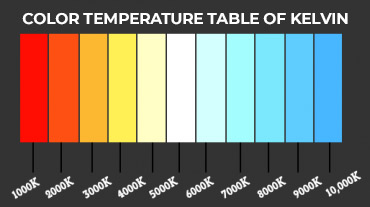What is KELVIN (Color Temperature)?
Kelvin is a unit of temperature measurement, denoted by the letter K used in science, whose unit range is the same as degrees Celsius (celcius) but accepts absolute zero (-273.15 degrees Celsius) as the zero point.
Kelvin-degrees Celsius relation
0 ° C = 273K
100 ° C = 373K
In short, it is sufficient to add +273 to convert a temperature we measure in degrees Celsius to Kelvin.
The color of the light changes with the temperature of the filament. This is called color temperature theory. When we start to heat a metal that does not melt easily, it starts to turn red and light around 1000K. As we continue to heat it, the color starts to change. When we reach a temperature of 5000K, we reach an incandescent (white) color. If the temperature continues to be increased, it will turn blue at 10000K temperature. That is why the heat of light is indicated in Kelvin (K) and measured with a kelvin meter.
A new concept: KELVIN
Where did come from the concept of kelvin, which we had not met in daily life ?
Before LED and energy-saving bulbs, all home lighting was provided by filament bulbs. The concept of kelvin was unknown because these bulbs only emitted light in the range of 2700-3000K. However, as energy-saving bulbs and LEDs started to be used and the different color temperatures they offer, this concept became more familiar in today's life.
The color temperature of the light source is specified in the lighting products we purchase. Accordingly, while 2700-3500K gives warm colors, 5000K values will give natural white light, which we often call daylight. When the Kelvin value increases to 6500, a cold white light is obtained.
You can see which temperature occurs in which kelvin value in the above KELVIN COLOR TEMPERATURE TABLE.
Warm light (2700-3200 Kelvin)
Color temperatures of 2700 - 3200 kelvin are considered "warm light". Warm light generally provides a softer, good view and a comfortable atmosphere than bright cold light. For this, it is preferred in bedrooms, living rooms, dining rooms and restaurants. This color temperature should be preferred to provide comfort in home life.
Natural light (4000-5000 Kelvin)
Although warm light is generally accepted in homes, some people may prefer natural white light.
Natural white light has a color temperature of 4000 - 5000 kelvin.
It is preferred in offices, entrances and other working environments as it creates an energetic and refreshing mood for people and employees.
Cold light (5500-6500 Kelvin)
Cold white light can increase work efficiency in working environments, this color should be preferred for works where we need to see the details. Recommended for visual areas, security lighting and garages.
